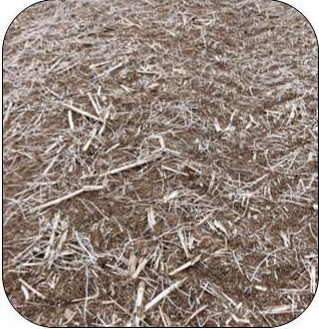Adding compost to grapes
Learn about adding compost to grape crops, the benefits, application rate, and how to apply.
For grape growers, compost can be a source of organic matter, can help supply a grape crops macro and micro nutrient requirements, and improve the soils water holding capacity and infiltration rates. Composts also has a side benefit of recycling waste products that would otherwise be landfilled.
When is a good time to apply compost to grapes?
Early spring to fruit set is a good time to apply compost to the vineyard, but no later than veraison. An earlier application of compost allows the vines to uptake and utilize of the available nitrogen and other nutrients during the growing season. Be careful of applying composts mid to late summer because too much nitrogen will keep the vines in a vegetative growth in the second half of the growing season, and can cause as excessive vine growth, poor grape colour, delayed hardening in the vine's woody tissue, and increased susceptible to grape winter injury. For these reasons, be careful applying compost to young vines.
What is a general application rate of compost that you can safely add to grapes this?
Grapes do not require a lot of nutrients for good yield. You can determine how much compost should you apply by taking samples of the nutrient levels in the soil, grape petioles, and in the compost you plan to apply.
Based on the OMAFRA Guide to Fruit Production (Publication 360), 30 lbs Nitrogen/acre (34 kg Nitrogen/ha) each year is adequate for most vineyards. 30 lbs of Nitrogen would equal approximately 6 tons of compost per acre of grapes, based on average mature compost nitrogen levels being 4–6 lbs Nitrogen for every tonne of compost applied per acre.
What does 6 tons of compost look like when it is applied to the vineyard?
If you have not applied compost before, you may be surprised that 6 tons of compost per acre is barely visible on the soil surface. This picture shows what 7.5 tonnes/ac of 50% dry matter compost application to corn residue. If you did cover the soil completely, your application rate would be too high and likely result in excessive nitrogen for grapes.
If you have no compost or soil analysis available, start with a modest first compost application of 2–5 tonnes compost/acre. It may not seem like a lot, but remember that due to nitrogen mineralization, compost can still provide Nitrogen to the grapes 3 or 4 years after you have applied it. Keep records of your compost application rates, and remember to adjust your fertilizer applications to account for this extra nitrogen released over time. Over the summer and fall, collect soil and grape petiole samples, and monitor vine growth and grape quality before increasing the compost application rate next year.
Submitting a compost sample to the lab? What analysis should you ask for?
Because the nutrient contents of composts can be highly variable, it is important to submit a sample of the compost to a local field laboratory to determine exactly what nutrient levels are being applied to your vineyard. Ask for a both nutrients (Nitrogen (Nitrite+Nitrate (NO3) and Ammonium+Ammonia (NH4), Phosphorus (P) and Potassium (K) and compost maturity (as C:N ratio). A mature compost will have a C:N ratio around 20:1. A immature compost will have a C:N ratio higher than 20:1 (for example, 30:1), and may actually tie up nitrogen in your soil as it continues to decompose to a stable form.
Some comments about the best type of compost for Grapes?
Since most winegrowers focus on providing adequate nitrogen and potassium for their vines, compost with some potassium is beneficial for grape application. Research from California has shown blends of grape pumice and animal manure composts are preferred since the potassium levels are normally higher than compost made entirely of municipal greenbin waste.
How to apply compost?
Composts are typically broadcast between grape rows, and sometimes top dressed onto existing cover crops. Grower experience shows it takes 3 to 5 years of soil building program like adding composts and cover crops to make a noticeable difference in sol organic matter levels, and the vineyards growth. So be patient, Rome was not built in a day!
